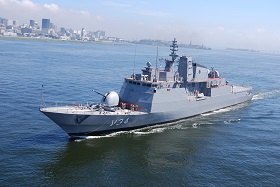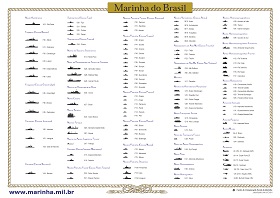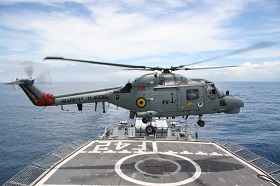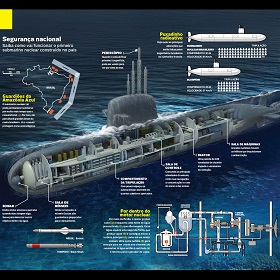Brazilian Navy: Protecting Stranger Coasts
Greenhalgh-class frigate
In
Login if you are already registered
(votes: 5, rating: 5) |
(5 votes) |
PhD in History, Expert on Latin America expert, RIAC expert
The official motto of the Brazilian Navy is “Protegendo nossas riquezas, cuidando da nossa gente” (Protecting our riches and taking care of our people). Whereas the latter part is almost philosophical, the former emphasizes the important role of the navy for the country with the ocean coastline of 8,500 kilometers. Importantly, there is a lot to protect in the territorial waters and the exclusive economic zone adjacent to the shore.
The official motto of the Brazilian Navy is “Protegendo nossas riquezas, cuidando da nossa gente” (Protecting our riches and taking care of our people). Whereas the latter part is almost philosophical, the former emphasizes the important role of the navy for the country with the ocean coastline of 8,500 kilometers. Importantly, there is a lot to protect in the territorial waters and the exclusive economic zone adjacent to the shore.
Challenges to security
Early in the 21st century, Brazil managed to evolve from an importer of petroleum to a major oil exporter. This is mostly due to the fact that from 2005 to 2010, more than 50% of the world’s oil discoveries were in deep waters, of which 63% were on the Brazilian shore. Petrobras CEO in 2012 predicted that in 2030, Brazil would be the country with the highest production growth among non-OPEC countries. Currently Brazil produces approximately 2.5 million barrels on a daily basis, including 90% of shelf oil.
Most of Brazil’s major cities are located on the shore, and most of the vital infrastructure facilities are close to the sea border. Moreover, sea transportation accounts for 95% of the country’s trade, whereas the fishing industry is developing at an enormous rate (showing a growth by 27% from 2003 to 2010) and, according to the government’s estimates, its output is expected to reach 146 million tons of fish by 2020. Freshwater appears to be an equally important asset — Brazil accounts for 12% of the world’s freshwater reserves, and its rivers are important components of the country’s infrastructure (37,000 kilometers of navigable rivers).
It is for this reason that the defense doctrine of Brazil, adopted in 2008, envisages the need for the Navy to temporarily shift its focus towards the defense of the country’s sea borders and the exclusive economic zone from building its power projection capacity. The document lists the Navy’s four priorities: 1. Active protection of the oil platforms; 2. Active defense of the naval and port infrastructure, archipelagos and islands in Brazil’s territorial waters; 3. Readiness to respond to any threats to trade routes from foreign states or unconventional forces; 4 Readiness to join any peacekeeping operations outside Brazil under the aegis of the United Nations or another multilateral organization.
But from whom does Brazil require protection? Given the decay of the once powerful Argentinean armed forces, the country has no serious opponents in the region. This prompted some authors to compare the positions of Brazil and the United States and draw conclusions that, just as the global superpower, Brazil has no landward threats and could focus entirely on the Navy. Given Brazil’s ambition to play a leading role at least in the region and gain a stronger foothold in the global economy, the main threats to its interests come from powers outside the region.

Barroso corvette
These include primarily the United Kingdom and the United States. The former empire has retained a strong position in the South Atlantic, with several naval bases, and its military presence in the Falkland Islands is constantly growing stronger. Furthermore, when making development plans for the Royal Navy (in constant political discussions and struggle for funding), the British authorities often cite the need to protect the islands in the South Atlantic. It would be a mistake to think that only Argentina is bothered by these statements. All countries in the region, in which Brazil considers itself to be the leading power, are keeping a watchful eye on the British military preparations. Interestingly, Brazil’s military regime (anti-Communist by its origin and essence), according to reports published in 2012, was ready to collaborate even with Cuba and the USSR in order to support the Argentinean armed forces in the war of 1982. Brazil still supports Argentina in its territorial dispute with the United Kingdom.
The countries of the region are also concerned over the symbolic gesture by the United States to revive the U.S. 4th Fleet (U.S. Navy command in the South Atlantic Ocean in 1943–1950, which was reestablished in 2008). The Brazilian president, along with the state leaders of Argentina and Venezuela, condemned the move, saying that the initiative by the U.S. mighty signal that Washington coveted new oil reserves off Brazil’s coast.
When it comes to the threats from unconventional forces mentioned in the doctrine, the authors must refer to the security of the country’s river basins in impassible areas (including on the borders with Peru, Bolivia, and Colombia, where drug trafficking is a serious challenge). Another threat comes from across the ocean from African countries, primarily Guinea-Bissau, which has been actively involved in drug trafficking as part of the global route to deliver cocaine from Latin America to the European Union.
As for the engagement of the Brazilian Navy in international operations, the best-known incidents include the fleet’s role in securing Brazil’s mission to Haiti and participation of Niterói-class frigates in the United Nations Interim Force in Lebanon.
Fleet status
The Brazilian Navy is historically responsible for the entire range of measures to ensure sea and river navigation. The country has no civil port services, as all ports are under the jurisdiction of the Navy port service. Further, the Navy provides coastguard services preventing smuggling, drug trafficking, and poaching. This is the main reason why the country’s Naval Personnel is so numerous, approximately 60,000.
Structurally the Navy consists of the Fleet, Naval Districts, Directorate of Hydrography and Navigation, and Marine Corps. The Fleet incorporates two escort fleets, the submarine fleet, and Naval Aviation. There are nine Naval Districts, each designated by a one-digit number. Districts 1, 2, 3, 5, and 8 cover the sea coast, District 4 covers most of the northeastern coastline and the lower course of the Amazon, whereas Districts 6, 7, and 9 are located within the continental portion of the country (river basins). Specifically, District 9 is responsible for the western Amazonia. Each District operates at least one base. The largest naval bases are Rio de Janeiro and Aratu.
The Surface Fleet consists of one Clemenceau-class aircraft carrier, the São Paulo (former French Navy Foch, originally launched in 1960), which is currently undergoing modernization), six Niterói-class frigates (the British Mk 10 project, all were launched between the mid-1970s and the mid-1980s and were extensively modernized between 1996 and 2005), three Greenhalgh-class frigates (built in the first half of the 1980s for the British Royal Navy (Type 22) and sold to Brazil from 1995 to 1997), three Inhaúma class corvettes (became part of the Brazilian Navy in the 1990s and have undergone modernization since 2008), and one Barroso corvette (built at a Brazilian shipyard and commissioned in 2008).

The Brazilian Navy
The Submarine Fleet consists of five diesel-electric submarines — four Tupi-class (German IKL 209.4 project) and one modified Tikuna (IKL 209-1400mod project) submarines. The first Tupi-class submarine was built in Germany and commissioned in 1989; the rest of them were built at Brazil’s AMRJ (Arsenalde Marinhado Rio de Janeiro) shipyard and were launched from 1994 to 1999. It was planned to build three more submarines of this type, but the decision was first postponed, and then Brazil opted for French-made submarines and their manufacturing technologies. The Tikuna submarine was also built at AMRJ and commissioned in 2005. Both types carry 16 Mk24 Tigerfish torpedoes that can be fired from eight torpedo launchers. The range of the submarines is 10,000 nautical miles, and their endurance is 50 days.
The Surface Fleet also includes four landing ships — one Mattoso Maia-class tank landing ship (former U.S. Newport-class landing ship launched in 1969 and transferred to Brazil in 2001); NDCC Almirante Saboia (formerly Britain’s Sir Bedivere, launched in 1966); newer NDCC Garcia D'Avila (former British Sir Galahad, launched in 1986 and sold to Brazil in 2007), and two dock landing ships (former U.S. Thomaston-class ships, launched in 1954 and 1957, respectively).
The Brazilian Navy also operates two tankers built in Brazil, which were commissioned in 1968 and 1989, two training ships (including NVe Cisne Branco sailing frigate) and NSS Felinto Perry, a rescue ship.
The coastal and river flotilla consists of two Imperial Marinheiro-class corvettes (built in the 1950s), two new Macaé-class patrol vessels built at Brazil’s INACE shipyard, 27 river patrol vessels (the most contemporary vessels include 12 Grajaú-class ships built at AMRJ and launched from 1994 to 2000, four Bracuí-class ships transferred from the United Kingdom; the rest were built at AMRJ in 1960–1970), two patrol vessels, one river monitor, three river transport ships and one support vessel.
The Fleet is supported by 19 auxiliary vessels, specifically oceanographic research vessels, including the Vital de Oliveira-class vessel received from China in 2015.
The Brazilian Naval Aviation consists of the air wing operating from the aircraft carrier São Paulo and helicopters. The aircraft carrier is the base for A-4 Skyhawks fighters (renamed AF-1 and AF-1A (two-seat)) in Brazil, acquired in Kuwait in 1997. Of the 23 acquired fighters, it was decided to modernize 12. Embraer signed a contract for the modernization of the aircraft; however, so far only two aircraft have been commissioned.
The Navy also operates six S-70 multi-mission helicopters (the export version of the U.S. SH-60 Seahawk, four were delivered in 2012 and two more in 2015 under the contract signed in 2010). These new helicopters will gradually replace the nine outdated S-61/SH-3D SeaKing helicopters, which remain operational. The fleet of multi-mission heliports also includes 12 Lynx 21/A aircraft, which, according to announced plans, will soon be suspended for midlife upgrade. Further, in 2008, Brazil contracted supplies of 50 modern multi-mission EC725 Caracal helicopters made by Eurocopter, worth 1.85 billion euro (mostly for the Air Force; the Navy will have only 16 new helicopters). The assembly of the helicopters will be completed in Brazil. So far, three helicopters have been supplied to the Navy. The Naval Aviation also includes seven older versions of the helicopter, AS332/532 Cougar. The remaining 19 AS350, nine AS355 and 17 Bell 206 machines operated by the Brazilian Navy are light helicopters.
Prospects for the Modernization and Strengthening of the Fleet
One of the most notable projects for the modernization of the Brazilian Navy is, definitely, the program for the modernization of São Paulo aircraft carrier and the creation of modern infrastructure for its stationing. The respective plans were announced in 2014. The modernization will be performed at the AMRJ shipyard and will involve DCNS, a French company. Technical details were agreed upon in March 2015, but in June the French side announced, that until now the final agreement has not been signed yet, but "it could happen in the near future." During modernization it is planned to significantly improve the accommodation conditions for the crew, replace all pipes and cables, install new engines and power plants, restore and modernize the old steam catapults (after modernization they will able to launch aircrafts weighing more than 20 tons), replace old radars, communication and control systems and install a number of new systems – from air conditioning systems to aircraft hoists. The modernization should be completed in 2019, and the service life of the aircraft carrier will be extended until 2039.
Earlier, there were reports on the possibility of construction or purchase of another aircraft carrier, but in the current economic situation it seems unlikely.
At the same time, the program for the modernization of naval aviation is being developed slowly but steadily. This applies to both aircrafts, which are based on the São Paulo, as well as shore-based aircrafts and helicopters, which have already entered service, as well as future surface ships. The modernization of A-4 Skyhawk deck-based multi-purpose fighters is underway. Elbit System's Brazilian Subsidiary, AEL Sistemas, acts as a partner of Embraer. It will install modern avionics, so-called "glass cockpit" (universal displays instead of analogue devices), modernize radars, warning systems, communications systems, oxygen supply equipment, navigation systems and so on. Additionally, the carrier will receive cargo aircrafts. On November 7, 2014 the Brazilian Navy signed a new contract to modernize Grumman C-1A Trader aircrafts to the level of KC-2 Turbo Trader in the transport version and the flying tanker version. The first modernized aircraft will enter service in December 2018. One of the subcontractors will be the US subsidiary of Elbit Systems. The total value of the contract will amount to USD 106 million. The aircrafts will receive a new "glass cockpit", new communication systems, an air refueling system and new Honeywell TPE-331 engines. A total of four aircrafts will be modernized. It is worth mentioning that, according to Flightglobal World Air Forces in 2015, Brazil has a total of four aircraft of this type, while São Paulo can host up to six Grumman C-1A Trader aircrafts – three transport ones and three AEW ones.
The six S-70 helicopters, which have already been acquired, will be enough for the formation of an anti-submarine helicopter force of the aircraft carrier. However, it is yet not known, whether all of them will be allocated on board of São Paulo or will be distributed among other ships. Pursuant to the 2008 contract, the option for the purchase of this equipment amounts to 12 units. These helicopters can carry out missions both against enemy surface forces and against submarines.
Another important agreement for naval aviation is the program to modernize eight multi-purpose Lynx Mk21A helicopters. The value of the contract, which involves the extension of service life and the replacement of engines, amounts to USD 160 million.
Since 2008, a contract to supply 16 EC 725 Caracal helicopters for the of the Navy is being implemented. These helicopters will be used for rescue operations and transfer of forces and goods.
Not less, but rather a more important part of the agenda for the modernization of the Brazilian Navy is the commissioning of new submarines and the project for the construction of the first-ever Brazilian nuclear submarine.
No additional information on the programs to purchase aircrafts for reconnaissance and refueling operations, which were announced in 2012 (MASK (Maritime Airborne Surveillance and Control), COD (Carrier On-board Delivery) and AAR (Air-to-Air Refuelling) programs) is yet available. It is planned to purchase five aircrafts: three reconnaissance aircrafts, one transport aircraft and one refueling aircraft.
Not less, but rather a more important part of the agenda for the modernization of the Brazilian Navy is the commissioning of new submarines and the project for the construction of the first-ever Brazilian nuclear submarine. The importance of this direction for the development of the Brazilian Navy is evidenced by the fact that no economic hardships have yet affected the ProSub program to equip the fleet with new submarines. Overall, the leadership of the Brazilian Navy looks forward to extending the fleet to include 15 diesel-electric submarines and 6 nuclear submarines. In 2009, the Brazilian Navy signed a contract with DCNS, a French company, to build four Scorpene-class diesel-electric submarines and render assistance in the development of the non-nuclear portion of nuclear submarines. All submarines will be built on a specially built shipyard, which was commissioned in December 2014. The first new diesel-electric submarine will be constructed in 2016. The entire construction program should be completed by 2022. The first nuclear submarine shall enter into service in 2025. Thus, Brazil will not only become the first country in Latin America, which can build their own submarines, but will also join the prestigious club of owners of nuclear submarines. All submarines will be equipped the same types of weapons – IF-21 Black Shark torpedoes and SM-39 Exocet missiles. The Prosub program, according to the head of the Brazilian Navy, Admiral Julio Soares (Julio Soares de Moura Neto), will cost more than USD 2 billion.
A key component of the modernization of the Brazilian Navy's surface forces is the so-called Prosuper program. The primary objective of this program is the construction of six frigates with the displacement of 6 thousand tons, five patrol boats with the displacement of 1,800 tons and a transport ship with the displacement of 13 thousand tons. The solution to this challenge will only replace the vessels, which have been decommissioned from the Navy in the mid-1990s. The program also provides for the "best-case scenario". But because of its apparent impracticability (primarily due to the lack of funding), it is not considered here, but to get an insight of its scale, it is worth noting that the total amount of frigates, which the Navy would like to order, amounts to 30 vessels.
This program, as well as in the case with the submarines, in addition to the construction of ships for the Navy, makes provisions for obtaining construction competencies and technology transfer. It is noted that the transactions should be mutually beneficial: "the contracts should yield benefits of industrial, technological and commercial nature. This is a mandatory requirement for all contracts of this kind with foreign companies, which exceed five million dollars."
Brazil will not only become the first country in Latin America, which can build their own submarines, but will also join the prestigious club of owners of nuclear submarines. All
At the same time, the document clearly states that Brazil intends to use these technologies to create its own solutions and introduce them to the world market.
Despite this, companies from six countries expressed their desire to participate in this production program: Germany, South Korea, Spain, Italy, the Netherlands and the United Kingdom.
In addition to large ships, Prosuper makes provisions for the construction of corvettes with the displacement of 2,400 tons (modernized Barroso class vessels), patrol boats with the displacement of 500 tons (Macaé class), four hydrographic river vessels for the implementation of the Amazon river mapping and up to 15 new river patrol boats.
Brazil has already mastered the construction of Macaé class patrol vessels, which were designed in France and built at the EISA shipyard. In 2009 and 2010 first two ships of this class entered into with the Brazilian Navy. In May 2015 a Spanish company Navantia signed a contract for rendering advisory services to EISA for the construction of this type of vessels and the establishment of a joint venture for this purpose. As of today, 4 Macaé class ships are under construction, and the planned production volume is 27 vessels.
It is worth noting that Navantia, trying to seize the Brazilian contracts from its competitors from France, would like to expand its relations with the South American giant. Thus, its director Fernando Migeles declared the willingness of the Spanish side to participate in all programs for the modernization of the fleet in Brazil. In particular, he announced the actual readiness of their company to share frigates construction technologies, noting that only the first ship will have to be built in Spain "for the training of Brazilian personnel."
In the meanwhile, Barroso corvette is the only ship of this class with the Brazilian Navy. It has entered service in 2008 and is considered to the most modern Brazilian warship. Brazilian authorities intend to continue the construction of such ships and make certain improvements to the project. The new Barroso will have increased displacement (2,480 against 2,350), the crew will be increases to 185 members, it would be less visible to radars, it will able to take on board S-70 Sea Hawk helicopters and will get anti-aircraft missiles.
Brazil intends to develop its own project to replace the Marajó oil tanker, which is already obsolete and is nearing the end of its service life, as well as the project for the creation of its own anti-ship missile on the basis of the French Exocet (MM-40) class missile.
Interim Results

12 Lynx 21/A
"The Brazilian Navy should become a balanced force, and should have all the modern facilities, provided for by the political and strategic agenda of our country in the international arena in accordance with the desires of Brazilian society," states the official website of the Brazilian Navy.
The problems, which were faced by the ruling party in 2014 and which persist up to this day, suggest that the "strategic agenda" of the government and "the desire of Brazilian society" do not agree. The funding of extremely expensive projects for the modernization of the fleet comes across public discontent in the face of a decline in living standards. In addition, the situation is affected by the features of the mentality of Brazilians, who do not see defense issues as one of the top priorities.
But this does not affect the geopolitical environment. Brazil, if it looks forward to leadership in its region, has to build an adequate Navy, which will correspond to this role. In addition to the above, virtually all large ships (with the displacement of more than 2 thousand tons) of the Brazilian Navy, except São Paulo and Barroso, will be decommissioned by 2025. The current submarine forces are obviously not sufficient either. With such a wide patrolling area Brazil needs nuclear submarines or a very large fleet of diesel-electric submarines with developed infrastructure.
As recently as in 2013 and 2014, opinions suggesting that Brazil has finally embarked on the road of active development of its Navy were heard from everywhere. Some experts reported on Brazil's "quiet naval expansion" and the creation of Brazilian "blue water" fleet (whereas a blue-water fleet is concerned with operations on the high seas), others predicted that the Brazilian Navy will be able to create at least one aircraft carrier battle group and will have a major submarine fleet by 2050. In positive economic environment all these forecasts seemed to be quite realistic.
The turning point was 2014, when many of the Brazilian development programs were stalled. In May 2015 Brazil's defense minister, Jacques Wagner declared that the Prosuper program will be frozen: "It is impractical to plan the construction of new ships against the background of budget cuts." He also noted that the production rate of EC725 helicopters for the Air Force and the Navy will be decelerated due to financing problems.
It should be noted that as far back as in October 2014 the Minister of Defense Celso Amorim declared the priority of the country's naval rearmament program and mentioned, among other things, the Prosuper program. The difference between these two statements of the Ministers is only six months.
It looks like the program for the construction of submarines will remain the "holy cow" of modernization of the Brazilian Navy. First, in the absence of adequate surface fleet submarines can become an "asymmetric response" to the enemy in the territorial waters, and second, huge amounts of money and the reputation of Brazilian leadership was invested into their construction. Dilma Rousseff, Brazilian President, has personally declared the country's accession to the club owners of nuclear submarines at the opening of Unidade de Fabricação de Estruturas Metálicas (Ufem), the shipyard where these submarines will be built. In addition, only the creation of the ground prototype nuclear reactor cost USD 7.5 million. The construction of diesel-electric submarines is also already underway, and closing a newly built shipyard for their construction hardly matches the plans of Brazilian government. Those programs, the activities for the implementation of which have already been deployed in the territory of Brazil, are also likely to remain intact. This is primarily the construction of Macaé class patrol ships and possibly the new version of Barroso corvette.
Among other things, these programs can bring a considerable profit to the country. Thus, Angola has ordered the construction of four Macaé class patrol ships from Brazil and plans to build three more ships at its shipyards with the participation of Brazilian experts. This example, among other things, proves that investment in the fleet as a kind of high-tech industry in the localization of production and technology pays back. Therefore it is not surprising that the current opposition, which is criticizing the "military-oriented spendings" of the president from the Workers' Party, will resume the construction of the fleet after coming to power, renouncing, for example, some social welfare programs.
(votes: 5, rating: 5) |
(5 votes) |





